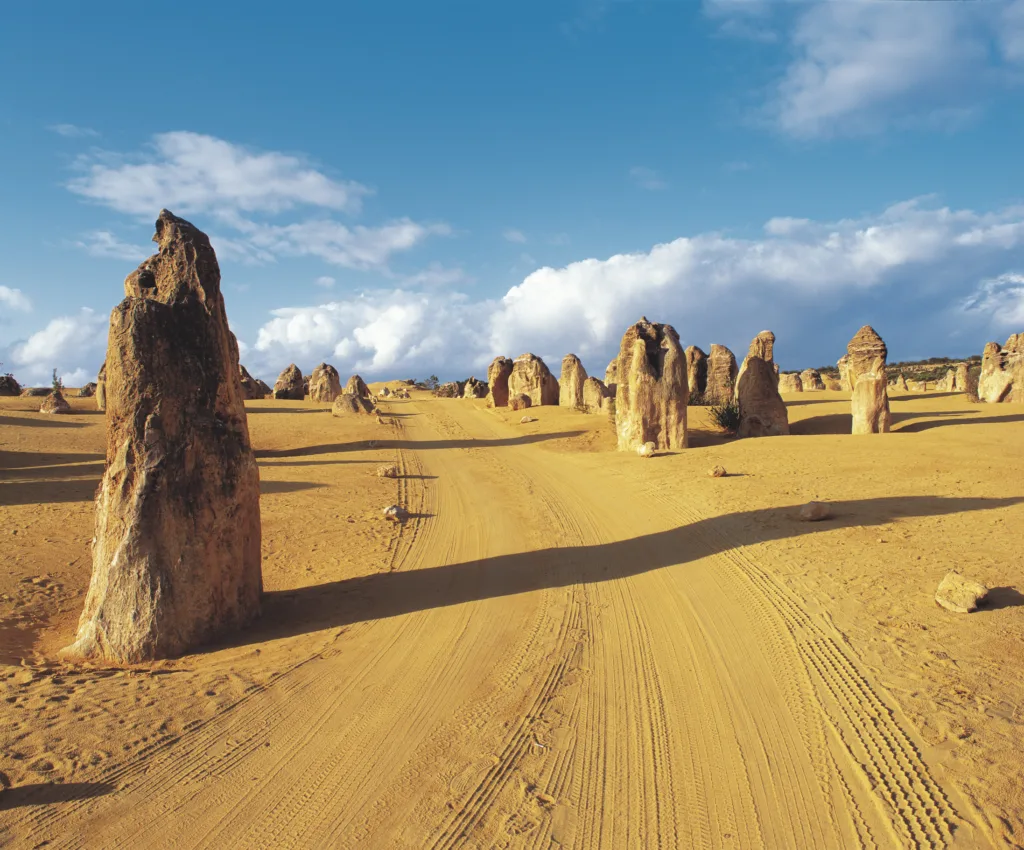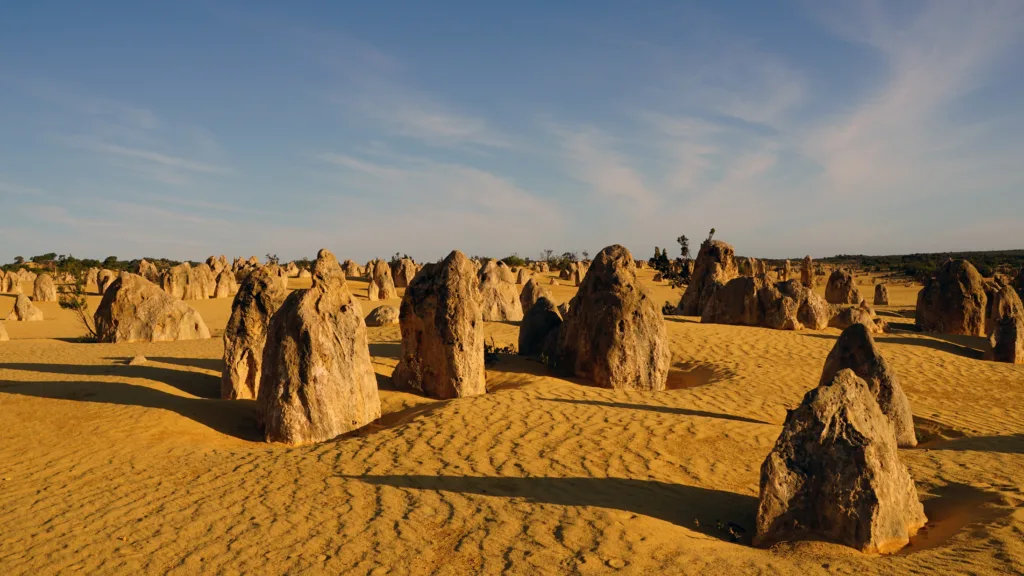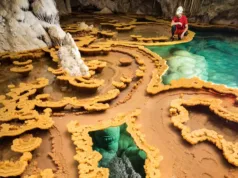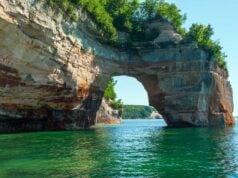Pinnacles Drive in Nambung National Park is a breathtaking natural attraction located in Cervantes, Western Australia. This unique and otherworldly landscape draws visitors from around the world, offering a glimpse into the remarkable geological formations known as the Pinnacles.


Definition and Location: The Pinnacles are a collection of limestone formations that rise from the desert sands, creating a surreal and almost alien-like landscape. These formations vary in size, shape, and height, with some towering several meters into the air. They are made primarily of calcium carbonate, formed over thousands of years through the accumulation of seashell fragments.
Nambung National Park, encompassing the Pinnacles, is situated on the Turquoise Coast, about 245 kilometers north of Perth, the capital city of Western Australia. Cervantes, a small coastal town, serves as the gateway to the Pinnacles Drive and is the primary access point for visitors.
Significance and Interest:
- Geological Wonder: The Pinnacles are a geological marvel, offering a unique opportunity to witness the intricate processes of nature. The formation of these limestone spires began millions of years ago when seashells accumulated on the ocean floor. Over time, geological forces, wind, and erosion sculpted them into the unusual shapes we see today.
- Astronomy: In addition to their geological significance, the Pinnacles are a popular location for stargazing due to their remote desert location. Visitors can marvel at the clear night skies, making it a destination for astronomy enthusiasts.
- Tourism and Photography: The Pinnacles Drive is a top tourist attraction in Western Australia, attracting photographers, nature enthusiasts, and adventure seekers. The contrast between the golden sands of the desert and the eerie, pale limestone formations creates a surreal and photogenic backdrop.
- Flora and Fauna: While the Pinnacles themselves are the main attraction, the surrounding Nambung National Park is also rich in flora and fauna. Visitors may encounter a variety of plant and animal species adapted to the harsh desert environment.
- Aboriginal Heritage: The area holds cultural significance for the local Indigenous people, the Nanda and Nhanda tribes. They have a deep connection to the land and consider it a part of their heritage.
- Visitor Experience: There are well-maintained walking trails and a designated Pinnacles Desert Discovery Centre, where visitors can learn more about the geological processes and history of the area. Additionally, visitors can take a scenic drive through the desert to witness the Pinnacles up close and enjoy panoramic views of the landscape.
In conclusion, Pinnacles Drive in Nambung National Park, Cervantes, Western Australia, offers a one-of-a-kind experience, combining geological wonder, natural beauty, cultural significance, and opportunities for adventure and exploration. It is a must-visit destination for anyone traveling through Western Australia, offering a glimpse into the incredible forces of nature that have shaped our planet over millennia.
Geology of The Pinnacles

Formation: The Pinnacles are a unique geological formation that has been shaped over millions of years. Their formation can be attributed to a combination of processes, primarily involving the accumulation of marine shells and subsequent erosion.
- Accumulation of Marine Shells: The process began around 25,000 to 30,000 years ago during the last Ice Age when the sea levels were lower. At that time, the area was covered by shallow seas. Marine organisms, such as seashells and other calcium carbonate-rich materials, accumulated on the ocean floor.
- Formation of Limestone: Over time, these accumulated organic materials were subjected to pressure and compaction, leading to the formation of limestone. The calcium carbonate from the shells became cemented together, creating a porous and easily eroded rock.
- Erosion and Exhumation: After the sea levels receded, the exposed limestone was subjected to various erosional forces, including wind and rain. These erosional processes began to shape the limestone into the unique forms we see today.
Composition: The Pinnacles are primarily composed of limestone, a sedimentary rock made up of calcium carbonate (CaCO3). The calcium carbonate in the Pinnacles comes from the shells of marine organisms, which accumulated on the ancient seabed.
Geological Features: The Pinnacles exhibit several distinctive geological features:
- Limestone Pillars: The most iconic feature of the Pinnacles is the numerous limestone pillars or spires that rise from the desert floor. These pillars can vary in height, with some reaching several meters tall, and they come in various shapes and sizes.
- Pitted and Weathered Surfaces: The surface of the limestone pillars often displays pitted and weathered textures, which have been shaped by centuries of wind erosion, sand abrasion, and occasional rainfall.
- Variety of Shapes: The Pinnacles come in a wide range of shapes, from slender, needle-like spires to more bulbous and rounded formations. Some appear as jagged spikes, while others have smoother contours.
Age of The Pinnacles: Determining the precise age of the Pinnacles is challenging due to the complex geological history of the region. However, it is generally accepted that the Pinnacles began forming around 25,000 to 30,000 years ago when the sea levels were lower during the last Ice Age. The accumulation of marine shells and subsequent processes of limestone formation and erosion have continued to shape the Pinnacles over thousands of years.
It’s important to note that while the formation of the limestone itself dates back tens of thousands of years, the specific shapes and structures of the Pinnacles are more recent, likely evolving over the last several thousand years as wind and erosion continued to shape the landscape.
In summary, the Pinnacles in Western Australia are a remarkable geological feature formed by the accumulation of marine shells, the subsequent formation of limestone, and the ongoing erosion by natural forces. Their exact age is challenging to determine precisely, but their formation is tied to geological processes spanning thousands of years.
Exploration and Discovery

The exploration and discovery of the Pinnacles in Nambung National Park, Western Australia, is a fascinating story that spans several centuries. Here’s an overview of the key moments and events related to the exploration and discovery of this remarkable geological wonder:
Indigenous Knowledge:
- The Indigenous people of the region, particularly the Nanda and Nhanda tribes, have inhabited and interacted with the land, including the Pinnacles, for thousands of years. They hold cultural knowledge and stories about the area, contributing to its rich heritage.
European Exploration:
- European exploration of the Western Australian coast began in the early 17th century, with Dutch and English explorers making initial contact with the continent.
- The Pinnacles and the surrounding region would have been largely unknown to European explorers until much later.
Settlement and Early Accounts:
- The first European settlers and explorers in the area likely encountered the Pinnacles in the 19th century as they expanded their settlements and ventured into the interior of Western Australia.
- Early accounts and descriptions of the Pinnacles by European settlers might have contributed to its recognition as a notable natural feature.
Recognition as a Tourist Attraction:
- The Pinnacles began to gain recognition as a tourist attraction in the 20th century as infrastructure and roads improved, making it more accessible to visitors.
- Local authorities and conservation efforts played a crucial role in promoting the Pinnacles as a destination for tourists and nature enthusiasts.
Conservation and Development:
- Nambung National Park, which encompasses the Pinnacles, was established in 1994 to protect the unique landscape and its natural heritage.
- Conservation efforts have been ongoing to preserve the fragile limestone formations and the surrounding ecosystem.
Visitor Facilities and Interpretation:
- To enhance the visitor experience and provide educational opportunities, the Pinnacles Desert Discovery Centre was opened. This center offers information about the geology, ecology, and cultural history of the Pinnacles.
- A well-maintained network of walking trails and a designated driving route (Pinnacles Drive) allows visitors to explore the area while minimizing environmental impact.
Ongoing Research and Study:
- Geologists and scientists continue to study the Pinnacles to better understand their formation and geological history.
- Ongoing research helps in appreciating the significance of this natural wonder and its role in the broader context of Earth’s geological processes.
In summary, the exploration and discovery of the Pinnacles in Nambung National Park represent a blend of Indigenous knowledge, European exploration and settlement, conservation efforts, and scientific research. Over time, the Pinnacles have evolved from a little-known natural feature into a globally recognized and celebrated destination for tourists and researchers alike.
Visitor Experiences

Visitor experiences at the Pinnacles in Nambung National Park, Western Australia, are as diverse as the landscape itself. Here are some of the key experiences and activities that visitors can enjoy when exploring this unique natural wonder:
- Scenic Drive: Pinnacles Drive is a designated route that allows visitors to take a scenic drive through the desert landscape, providing stunning panoramic views of the Pinnacles. It’s a great way to see the formations from the comfort of your vehicle.
- Walking Trails: The national park offers well-marked walking trails of varying lengths and difficulty levels. These trails take you up close to the Pinnacles, allowing for a more immersive experience. Some popular trails include the Desert View Trail, the Pinnacles Trail, and the shorter Pinnacles Loop.
- Photography: The otherworldly appearance of the Pinnacles makes it a photographer’s paradise. Whether you’re an amateur or a professional, you’ll find countless opportunities for capturing unique and captivating shots.
- Stargazing: Due to its remote location and minimal light pollution, the Pinnacles offer an excellent spot for stargazing. Visitors can marvel at the clear night skies and, on a clear evening, witness a breathtaking display of stars and celestial objects.
- Pinnacles Desert Discovery Centre: Located near the entrance to the Pinnacles Drive, this visitor center provides valuable information about the geological history, flora, fauna, and Indigenous culture of the area. Interactive exhibits and interpretive displays help visitors gain a deeper understanding of the Pinnacles.
- Picnicking: There are designated picnic areas where visitors can relax and enjoy a meal amidst the unique desert landscape. It’s an excellent way to take a break and soak in the natural beauty of the area.
- Wildlife Viewing: While the Pinnacles themselves are a major attraction, the surrounding national park is home to a variety of wildlife adapted to the desert environment. You may encounter kangaroos, emus, various bird species, and reptiles during your visit.
- Cultural Experiences: Visitors interested in the Indigenous culture of the area can learn about the heritage and stories of the local Nanda and Nhanda tribes. Some guided tours offer insights into the cultural significance of the Pinnacles.
- Sunset and Sunrise Viewing: The Pinnacles take on a different character during the golden hours of sunrise and sunset. Many visitors choose to time their visit to witness the stunning play of light and shadows on the limestone formations during these times.
- Camping: Camping facilities are available in the vicinity of the national park, allowing visitors to spend more time in the area and experience the tranquility of the desert at night.
- Educational Programs: Occasionally, guided tours and educational programs are offered by park rangers and local experts. These programs provide in-depth knowledge about the geology, ecology, and history of the Pinnacles.
- Rock Formations Exploration: Besides the main Pinnacles area, visitors can explore other interesting rock formations and features within the national park, including limestone caves and dunes.
Visitor experiences at the Pinnacles cater to a wide range of interests, whether you’re a nature lover, adventurer, photographer, or simply someone seeking a tranquil and awe-inspiring natural setting. It’s a destination that offers a deep connection with the natural world and the wonders of geology.
Reference Lists
- “Nambung National Park – Pinnacles Desert.” Western Australia Parks and Wildlife Service. https://parks.dpaw.wa.gov.au/site/nambung-national-park-pinnacles-desert.
- “The Pinnacles Desert – Nambung National Park.” Department of Biodiversity, Conservation and Attractions, Government of Western Australia. https://parks.dpaw.wa.gov.au/site/pinnacles-desert.
- “The Pinnacles Desert – Nambung National Park.” Department of Biodiversity, Conservation and Attractions, Government of Western Australia. https://parks.dpaw.wa.gov.au/site/pinnacles-desert.
- “The Pinnacles Desert – Nambung National Park.” Department of Biodiversity, Conservation and Attractions, Government of Western Australia. https://parks.dpaw.wa.gov.au/site/pinnacles-desert.




































